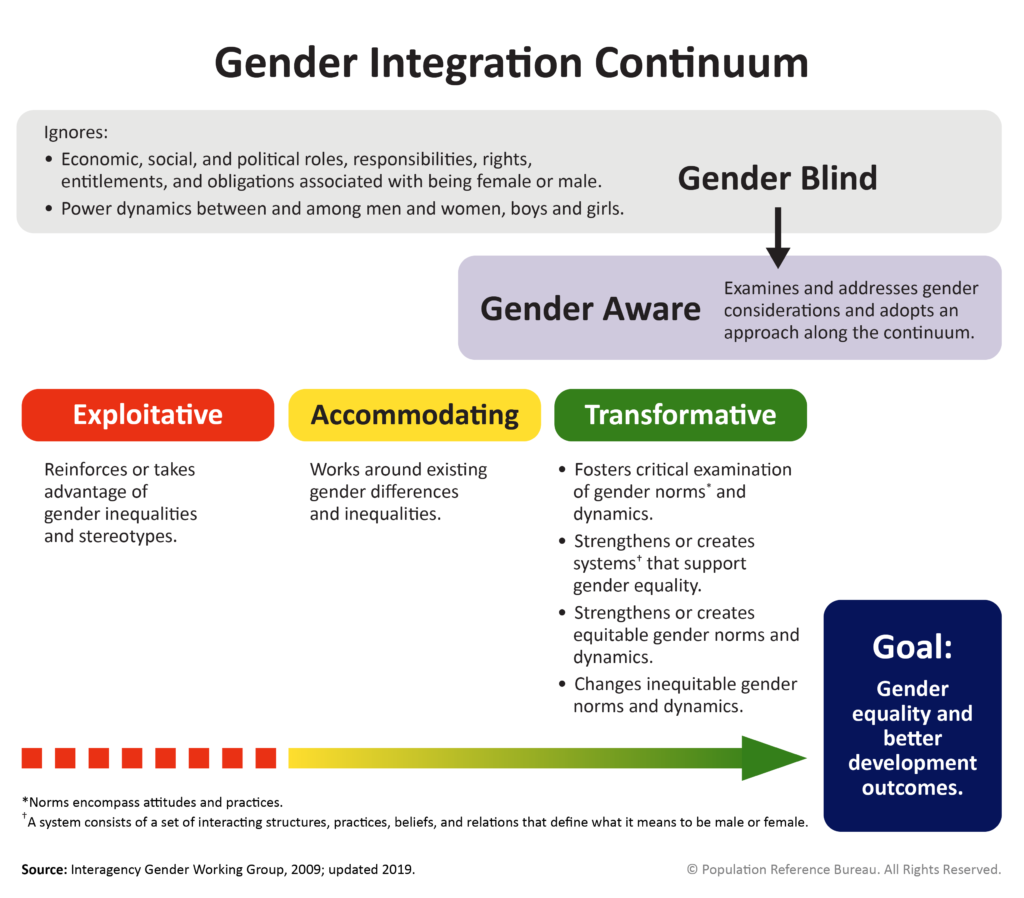Preparing for the Workshop
It is ideal to have a solid profile of your participant group in order to adequately tailor your material. Collecting a needs assessment survey from your participants is one of the simplest ways to identify their skill levels and needs for moving forward. Surveys are best sent out 2-3 weeks before your training date, and participants usually need 4-7 days to complete even a simple form. Information gathered in a needs assessment should directly relate to the material in the workshop and not raise unwarranted expectations; i.e., if you do not plan to address gender integration into CME programs, it is best not to ask a question about the topic in the needs assessment.
Use the simple needs assessment template as-is for the generic Gender 101 session or tailor it to apply to any of the 5 technical areas.
Needs Assessment Template
E-Learning vs. In-person Training
The IGWG does offer an abbreviated online version of the Gender 101 curriculum, which is a valuable resource, especially in contexts of severe time and budgetary limitations. In some cases, facilitators have chosen to require that participants take the e-learning module before attending a workshop in order to shorten or eliminate the Gender 101 sessions from the in-person training agenda.
There are benefits and drawbacks to both e-learning and in-person training. Generally, training is more effective when people can come together in person to discuss ideas, share stories and experiences and learn from each other. Therefore, whenever possible, users of the IGWG modules should strongly consider in-person training. However if budget and/or geography make gathering impossible to convene in one location, e-learning is an option to consider.
| In-person Positive Aspects | In-person Negative Aspects |
| In-person groups tend to build rapport and trust during the early sessions, leading to a natural sharing of experiences and stories for cross-learning. | Can be expensive: must provide transport for participants and/or facilitator—sometimes accommodation, meals, etc. |
| In-person relationships are more likely to lead to future partnerships and networking. | Can be difficult to balance a variety of schedules to allow for travel as well as training. |
| Can take advantage of a variety of visual aids | |
| Can take advantage of group activities for experiential learning. |
| E-Learning Positive Aspects | E-Learning Negative Aspects |
| Save money for travel budget. | Sense of distance between facilitator and participants. |
| Good for areas that have geography or security challenges. | Harder to engage all participants. |
| Good for cultures and situations that limit women’s movement. | Little opportunity for conversation or feedback. |
| Technology can malfunction: audio, video, internet provider, electricity, etc. |
The “Gender and Reproductive Health 101” e-learning course may be accessed through the USAID GHeL Center at www.globalhealthlearning.org.
Participants will need to create a user name and password to enter the site and access the courses. The course will take about one hour to complete; however, it is self-paced and can be completed at the participant’s convenience. Each session includes a Knowledge Check to assess prior knowledge at the beginning and a Skills Recap at the end to reinforce key messages. After successfully completing all of the course components, participants receive a certificate of completion.
During the Workshop
- Facilitators should always arrive early and be well prepared. Participants immediately sense disorder and can become nervous and even distrustful of facilitators in these circumstances. Ensure that the room set-up is well suited for the size of the group, temperature is comfortable, and refreshments are available. Have handouts, PowerPoint and flip-charts ready in advance and organized.
- Present objectives clearly and honestly. Encourage questions. If some participants have expectations that go above the planned objectives, help them to understand what will (and will not be) covered in the day’s agenda so they can better align their expectations to your training.
- Use correct verbal communication. Try not to ask yes/no questions. Ask open-ended questions that encourage dialogue, e.g., “Tell me more about that.” “Give me an example of that.” “That is an interesting perspective—how did you come to that conclusion?”
- Use correct non-verbal communication. Make eye contact withparticipants. Be open to their opinions and ideas by nodding your head when they speak. Try to be relaxed at the front of the room. Try not to cross arms or appear “closed off” to the participants.
- Be aware of group dynamics. Encourage quiet participants to speak out without putting them on the spot or making them uncomfortable. Encourage more talkative participants to allow others to share. “Let’s hear from someone else right now…”
- Adults learn best when they can immediately apply new knowledge to their own work or life. Encourage participants to share how they intend to use this new information—or ask for concrete ways in which they can integrate topics covered in the training to their projects and programs.
- Provide closure to each day. Even if you’re running short on time, take 10 minutes to bring the group to a close and allow participants to process the day’s information. Ask each individual to think of the top 1-2 learnings from the day and write them in their date book or journal. Explain that this information will be easy to find for follow-up when they return to the office the following day or week.


